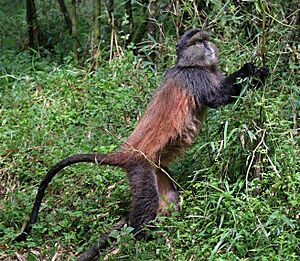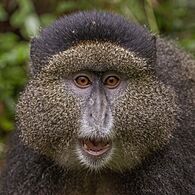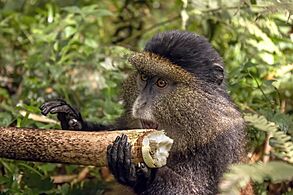Golden monkey facts for kids
Quick facts for kids Golden monkey |
|
|---|---|
 |
|
| Volcanoes National Park, Rwanda | |
| Conservation status | |
| Scientific classification |
|
| Kingdom: | Animalia |
| Phylum: | Chordata |
| Class: | Mammalia |
| Order: | Primates |
| Suborder: | Haplorhini |
| Infraorder: | Simiiformes |
| Family: | Cercopithecidae |
| Genus: | Cercopithecus |
| Species: | |
| Subspecies: |
C. m. kandti
|
| Trinomial name | |
| Cercopithecus mitis kandti Matschie, 1905
|
|
The golden monkey (Cercopithecus mitis kandti) is a special kind of blue monkey. It lives in the Virunga volcanic mountains in Central Africa. You can find these monkeys in four national parks: Mgahinga in Uganda, Volcanoes in Rwanda, and Virunga and Kahuzi-Biéga in the Democratic Republic of Congo. They prefer to live in highland forests, especially near bamboo plants.
Golden monkeys look a lot like blue monkeys. However, golden monkeys have a bright golden-orange patch on their upper sides and back.
We don't know a lot about how golden monkeys behave. They live in social groups that can have up to 30 monkeys. Their main food is bamboo, leaves, and fruit. They might also eat insects.
Sadly, the golden monkey is an endangered species. This means there aren't many left. Their homes are slowly being destroyed. Also, past conflicts in their habitat have made it harder for them to survive. Because of this, they are on the IUCN Red List.
Contents
Where Golden Monkeys Live and What They Eat
Golden monkeys love places with lots of fruit and bamboo. This is because these are their main foods. They move around different areas depending on the time of year. When ripe fruit is ready, they stay in those areas. When the rainy season starts, new bamboo shoots grow. Then, the monkeys move to places with lots of bamboo.
Studies show that if an area has both fruit and bamboo, golden monkeys like to visit it more. They prefer these mixed areas over places with only bamboo. Scientists have seen golden monkeys most often in bamboo forests. This suggests bamboo is a very important part of their home.
The Virunga mountains have different areas with varying amounts of food. Golden monkeys can change what they eat to match what's available. For example, in the Virunga massif, they eat a lot of bamboo shoots. But in the Gishwati forest, they eat mostly fruits and shrubs.
Golden Monkey Behavior and Social Life
Golden monkeys can live in groups of different sizes. Some groups are small, with only three monkeys. Others can be very large, with up to 62 monkeys! Groups found in higher mountain areas tend to be smaller.
After a day of finding food, golden monkeys often go back to one of their sleeping spots. They usually sleep in small groups of about four monkeys. They sleep at the very top of bamboo plants. They pick a thick bamboo plant or several plants woven together to make a strong bed. These monkeys often eat close to their sleeping area. They also tend to return to the same sleeping spot night after night.
What Golden Monkeys Eat
The golden monkey's diet mostly includes young bamboo leaves, fruits, bamboo branches, and bamboo shoots. They also eat small insects, flowers, and shrubs. However, golden monkeys are "opportunistic feeders." This means they will eat whatever food is easiest to find.
When ripe fruit is available, they eat more fruit. They might also eat different flowers and shrubs when they can find them. The insects they eat most often are butterfly larvae. They pick these tiny creatures from leaves. Bamboo is usually eaten the most because it is available all year round.
Protecting Golden Monkeys
The golden monkey is listed as an endangered species on the IUCN Red List. This means they are at high risk of disappearing forever. Some human activities threaten these monkeys.
Illegal activities like cutting down trees and removing bamboo are big problems. These actions harm the monkey's home. Some studies show that removing trees is an even bigger danger. Protecting their habitat is key to helping golden monkeys survive.






